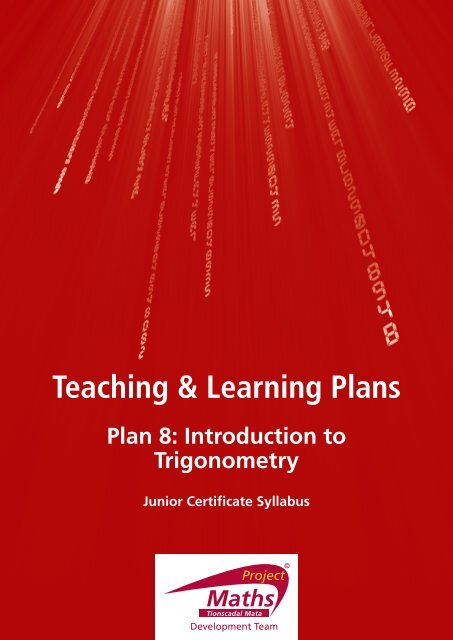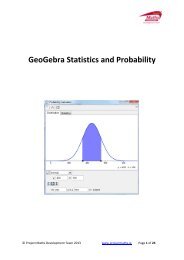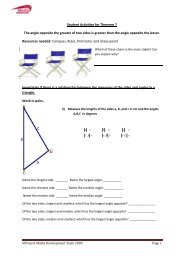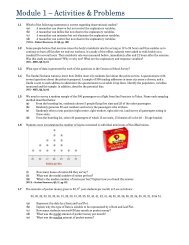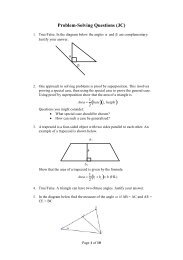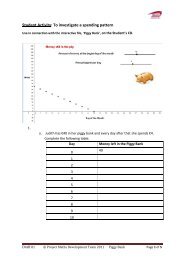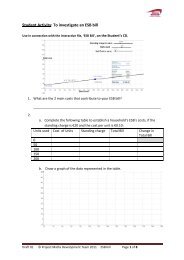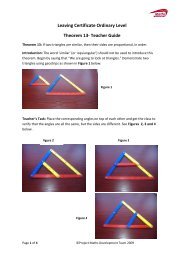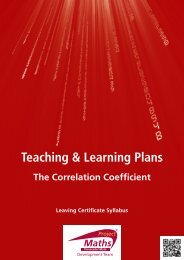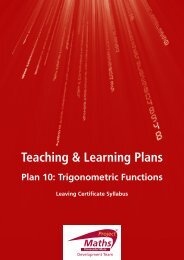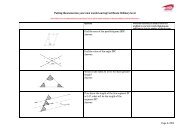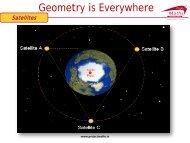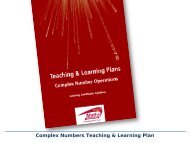Teaching & Learning Plan 8: Introduction to ... - Project Maths
Teaching & Learning Plan 8: Introduction to ... - Project Maths
Teaching & Learning Plan 8: Introduction to ... - Project Maths
You also want an ePaper? Increase the reach of your titles
YUMPU automatically turns print PDFs into web optimized ePapers that Google loves.
<strong>Teaching</strong> & <strong>Learning</strong> <strong>Plan</strong>s<br />
<strong>Plan</strong> 8: <strong>Introduction</strong> <strong>to</strong><br />
Trigonometry<br />
Junior Certificate Syllabus
The <strong>Teaching</strong> & <strong>Learning</strong> <strong>Plan</strong>s<br />
are structured as follows:<br />
Aims outline what the lesson, or series of lessons, hopes <strong>to</strong> achieve.<br />
Prior Knowledge points <strong>to</strong> relevant knowledge students may already have and also<br />
<strong>to</strong> knowledge which may be necessary in order <strong>to</strong> support them in accessing this new<br />
<strong>to</strong>pic.<br />
<strong>Learning</strong> Outcomes outline what a student will be able <strong>to</strong> do, know and understand<br />
having completed the <strong>to</strong>pic.<br />
Relationship <strong>to</strong> Syllabus refers <strong>to</strong> the relevant section of either the Junior and/or<br />
Leaving Certificate Syllabus.<br />
Resources Required lists the resources which will be needed in the teaching and<br />
learning of a particular <strong>to</strong>pic.<br />
Introducing the <strong>to</strong>pic (in some plans only) outlines an approach <strong>to</strong> introducing the<br />
<strong>to</strong>pic.<br />
Lesson Interaction is set out under four sub-headings:<br />
i. Student <strong>Learning</strong> Tasks – Teacher Input: This section focuses on teacher input<br />
and gives details of the key student tasks and teacher questions which move the<br />
lesson forward.<br />
ii.<br />
Student Activities – Possible and Expected Responses: Gives details of<br />
possible student reactions and responses and possible misconceptions students<br />
may have.<br />
iii. Teacher’s Support and Actions: Gives details of teacher actions designed <strong>to</strong><br />
support and scaffold student learning.<br />
iv.<br />
Checking Understanding: Suggests questions a teacher might ask <strong>to</strong> evaluate<br />
whether the goals/learning outcomes are being/have been achieved. This<br />
evaluation will inform and direct the teaching and learning activities of the next<br />
class(es).<br />
Student Activities linked <strong>to</strong> the lesson(s) are provided at the end of each plan.
<strong>Teaching</strong> & <strong>Learning</strong> <strong>Plan</strong> 8:<br />
<strong>Introduction</strong> <strong>to</strong> Trigonometry<br />
Aims<br />
• To introduce the concept of trigonometry<br />
• To understand the concept of sin, cos and tan<br />
• To apply trigonometry <strong>to</strong> solve problems<br />
Prior Knowledge<br />
Students should have knowledge of the concept of ratio and should know that<br />
division is not commutative. Students should be able <strong>to</strong> use a calcula<strong>to</strong>r <strong>to</strong> convert<br />
fractions, correct <strong>to</strong> three decimal places, measure the lengths of sides of a triangle<br />
<strong>to</strong> the nearest millimetre and draw <strong>to</strong> scale. Students should have studied Pythagoras’<br />
Theorem and know the meaning of the term “hypotenuse”. Students may have studied<br />
similar triangles in geometry – the fact that corresponding sides are proportional makes<br />
trigonometry possible. Students will have unders<strong>to</strong>od how <strong>to</strong> calculate mean. Students<br />
should know how <strong>to</strong> use a measuring tape and protrac<strong>to</strong>r.<br />
<strong>Learning</strong> Outcomes<br />
As a result of studying this <strong>to</strong>pic, students will be able <strong>to</strong><br />
• correctly identify the hypotenuse in a right angled triangle, and the<br />
opposite and adjacent sides of a given angle<br />
• find a pattern linking the ratio of sides of a triangle with the angles and<br />
hence understand the concepts of sine, cosine and tangent ratios of angles<br />
• apply trigonometry <strong>to</strong> solve problems including those involving angles of<br />
elevation and depression<br />
© <strong>Project</strong> <strong>Maths</strong> Development Team 2009 www.projectmaths.ie 1
<strong>Teaching</strong> & <strong>Learning</strong> <strong>Plan</strong> 8: <strong>Introduction</strong> <strong>to</strong> Trigonometry<br />
Relationship <strong>to</strong> Junior Certificate Syllabus<br />
Sub-<strong>to</strong>pics Ordinary Level Higher Level<br />
(also includes OL)<br />
Trigonometry<br />
Solution of right-angled<br />
triangle problems of a<br />
simple nature involving<br />
heights and distances,<br />
including the use of the<br />
theorem of Pythagoras.<br />
Functions of 30˚, 45˚ and<br />
60˚ in surd form derived<br />
from suitable triangles.<br />
Solution of right-angled<br />
triangles.<br />
Cosine, sine and tangent<br />
of angles (integer values)<br />
between 0˚ and 90˚.<br />
Decimal and DMS values<br />
of angles.<br />
Resources Required<br />
Calcula<strong>to</strong>rs, measuring tapes, graph paper, cm rulers and a sunny day!<br />
Introducing the Topic<br />
Trigonometry is simply geometrical constructions where the ratio of the side lengths in<br />
triangles is used <strong>to</strong> determine angular measurement.<br />
Trigon, meaning triangle and metria, meaning measurement<br />
Mathematicians have used trigonometry for centuries <strong>to</strong> accurately determine distances<br />
without having <strong>to</strong> physically measure them (Clinometer Activity Appendix A). It can<br />
also be used <strong>to</strong> calculate angles that would be very difficult <strong>to</strong> measure. Trigonometry<br />
has uses in such areas as surveying, navigation, drawing and architecture.<br />
© <strong>Project</strong> <strong>Maths</strong> Development Team 2009 www.projectmaths.ie 2
© <strong>Project</strong> <strong>Maths</strong> Development Team 2009 www.projectmaths.ie KEY: » next step • student answer/response 3<br />
<strong>Teaching</strong> & <strong>Learning</strong> <strong>Plan</strong> 8: <strong>Introduction</strong> <strong>to</strong> Trigonometry<br />
Student <strong>Learning</strong> Tasks:<br />
Teacher Input<br />
Outside Classroom<br />
»» We are going <strong>to</strong> find the<br />
angle of elevation of the<br />
sun. Fill in Student Activity<br />
1A.<br />
Inside Classroom<br />
»»<br />
Fill in Student Activity 1C.<br />
»» From your scaled diagram<br />
work out the angle of<br />
elevation of the sun.<br />
»» Now using the angle of<br />
elevation (from Student<br />
Activity 1C) and the length<br />
of the shadow of an object<br />
whose height you cannot<br />
physically measure (from<br />
Student Activity 1B), again<br />
use a scaled diagram <strong>to</strong><br />
determine the height of<br />
the object.<br />
Student Activities: Possible<br />
and Expected Responses<br />
»» Students measure one<br />
student’s height and the<br />
length of his/her shadow<br />
and fill in Student Activity<br />
1A.<br />
Lesson Interaction<br />
»» Students measure the<br />
length of the shadow<br />
of some tall object e.g.<br />
flagpole or goalpost and<br />
fill in Student Activity 1B.<br />
»»<br />
Students fill in Student<br />
Activity 1C <strong>to</strong> find the<br />
angle of elevation of the<br />
sun and check their answer<br />
with other students in the<br />
class.<br />
»»<br />
Students fill in Student<br />
Activity 1D <strong>to</strong> find the<br />
measure of some tall object<br />
and check their answer<br />
with other students in the<br />
class.<br />
Teacher’s Support and<br />
Actions<br />
»»<br />
Distribute Student Activity<br />
1 (sunny day necessary!)<br />
»» Walk around observing<br />
students as they take<br />
measurements.<br />
»» Circulate checking that<br />
students can draw a scaled<br />
diagram.<br />
Checking Understanding<br />
»» Have all students<br />
unders<strong>to</strong>od the task so far<br />
»» Can students identify the<br />
angle of elevation
© <strong>Project</strong> <strong>Maths</strong> Development Team 2009 www.projectmaths.ie KEY: » next step • student answer/response 4<br />
<strong>Teaching</strong> & <strong>Learning</strong> <strong>Plan</strong> 8: <strong>Introduction</strong> <strong>to</strong> Trigonometry<br />
Student <strong>Learning</strong> Tasks: Teacher<br />
Input<br />
»» Alternatively, you can use<br />
ratios in similar triangles. Fill<br />
in Student Activity 1E.<br />
Note: Later on, having learned<br />
about the trigonometric ratios of sin,<br />
cos and tan studentscan use these<br />
trigonometric ratios <strong>to</strong> determine<br />
the angle of elevation of the sun and<br />
hence the height of for example a<br />
tall tree or a goalpost.<br />
»» Why is the study of triangles<br />
important– show students<br />
the PowerPoint images in<br />
Appendix B.<br />
»» What is the hypotenuse of a<br />
right-angled triangle<br />
»» Collaborate in pairs as you fill<br />
in Student Activity 2.<br />
»» Mark the hypotenuse on the<br />
triangles in Student Activity 2<br />
of right-angled triangles.<br />
Student Activities: Possible<br />
and Expected Responses<br />
»» Students complete<br />
Student Activity 1E.<br />
• The longest side<br />
• The side opposite the 90°<br />
angle<br />
»» Students can mark the<br />
hypotenuse of each right<br />
angled triangle.<br />
Teacher’s Support and Actions Checking<br />
Understanding<br />
»» Have all students<br />
been able <strong>to</strong><br />
complete Student<br />
Activity 1E<br />
»»<br />
Distribute Student Activity 2.<br />
»» Have the heading “Right angled<br />
triangles” on the board. (RHS of<br />
the board should have heading<br />
“New Words”).<br />
»» Are all students<br />
able <strong>to</strong> identify<br />
the hypotenuse<br />
»»<br />
Draw a large right angled triangle<br />
with the right angle marked.<br />
»» Mark the hypotenuse on the board<br />
with an arrow <strong>to</strong> show that the<br />
side is opposite the right angle.
<strong>Teaching</strong> & <strong>Learning</strong> <strong>Plan</strong> 8: <strong>Introduction</strong> <strong>to</strong> Trigonometry<br />
Student <strong>Learning</strong> Tasks:<br />
Teacher Input<br />
»» How many other angles are in<br />
the triangle<br />
Student Activities: Possible<br />
and Expected Responses<br />
• Two<br />
Teacher’s Support and Actions Checking<br />
Understanding<br />
»»<br />
How many degrees do they<br />
add up <strong>to</strong><br />
• 90°<br />
»» What are these angles called<br />
»» Mark either one of the two<br />
complementary angles on the<br />
triangle with an arc. What is<br />
the name of one of the arms<br />
of that angle<br />
»» The other side, which is beside<br />
the marked angle, is given the<br />
name “adjacent”. Label it.<br />
• Complementary angles<br />
• The hypotenuse<br />
»» Label the hypotenuse on the<br />
triangle on the board.<br />
»» Students mark one angle<br />
with an arc and label<br />
the adjacent side <strong>to</strong> this<br />
angle on all the triangles.<br />
»» Label the adjacent and write<br />
the word “Adjacent” in the new<br />
words list on RHS of board.<br />
»» Tell students that the word<br />
adjacent means “beside”. They<br />
are sitting beside or “adjacent <strong>to</strong>”<br />
another student.<br />
»» Point out on the board that<br />
regardless of which of the two<br />
angles adding up <strong>to</strong> 90° is chosen<br />
by the student, the hypotenuse is<br />
one of the arms of that angle.<br />
»» Can all students<br />
identify the side<br />
adjacent <strong>to</strong> the<br />
marked angle<br />
»» Circulate checking that students<br />
can label the sides correctly;<br />
emphasising that the labelling<br />
of a side depends on the angle<br />
it refers <strong>to</strong>. Adjacent means<br />
adjacent <strong>to</strong> a particular angle.<br />
© <strong>Project</strong> <strong>Maths</strong> Development Team 2009 www.projectmaths.ie KEY: » next step • student answer/response 5
© <strong>Project</strong> <strong>Maths</strong> Development Team 2009 www.projectmaths.ie KEY: » next step • student answer/response 6<br />
<strong>Teaching</strong> & <strong>Learning</strong> <strong>Plan</strong> 8: <strong>Introduction</strong> <strong>to</strong> Trigonometry<br />
Student <strong>Learning</strong> Tasks:<br />
Teacher Input<br />
»» Label the third side of the<br />
triangle as the opposite<br />
side.<br />
Student Activities: Possible<br />
and Expected Responses<br />
»» Students label the side<br />
opposite the marked angle<br />
as the opposite.<br />
Teacher’s Support and<br />
Actions<br />
»» Check each group’s work as<br />
they are labelling the sides<br />
of the triangle.<br />
Checking Understanding<br />
»» Are all sides correctly<br />
labelled in each triangle<br />
»»<br />
Describe the opposite side.<br />
• If you were standing at the<br />
vertex of the marked angle<br />
it would be across from<br />
you or opposite you so it is<br />
called the opposite side.<br />
»» Repeat this process of<br />
marking angles and<br />
labelling sides for all<br />
the triangles on Student<br />
Activity 1.<br />
»» Students label 90° angle,<br />
the hypotenuse, one other<br />
angle then adjacent and<br />
then opposite sides.<br />
»»<br />
Circulate checking the<br />
work of each group.<br />
»»<br />
Are all sides correctly<br />
labelled in each triangle<br />
»» If you were <strong>to</strong> work out<br />
the ratio of any two of<br />
the sides in a right angled<br />
triangle how would you do<br />
this<br />
»» Would the order matter<br />
Explain your answer.<br />
»» Divide the length of one<br />
side by the length of<br />
another side using the<br />
same units.<br />
»» Yes, because 3/2 is not the<br />
same as 2/3 for instance.<br />
»» Ask students <strong>to</strong> think<br />
about the answer first and<br />
then ask a student for an<br />
answer.<br />
»» If a student cannot<br />
explain the answer, give<br />
two lengths and then ask<br />
the student if the order<br />
matters.<br />
»» Are students familiar<br />
with the concept of ratio<br />
and do they understand<br />
that division is not<br />
commutative
© <strong>Project</strong> <strong>Maths</strong> Development Team 2009 www.projectmaths.ie KEY: » next step • student answer/response 7<br />
<strong>Teaching</strong> & <strong>Learning</strong> <strong>Plan</strong> 8: <strong>Introduction</strong> <strong>to</strong> Trigonometry<br />
Student <strong>Learning</strong> Tasks: Teacher<br />
Input<br />
»» How many possible ratios could<br />
be worked out for a rightangled<br />
triangle<br />
»» When giving the ratios use the<br />
names for the sides.<br />
Student Activities: Possible and Expected Responses<br />
Teacher’s Support and Actions Checking Understanding<br />
• 6<br />
»» Write the ratios on the board »» Are the students able<br />
as students call them out<br />
placing multiplicative inverses<br />
beside each other.<br />
<strong>to</strong> take the 3 sides and<br />
combine them in<strong>to</strong> 6<br />
pairs<br />
»» What is the relationship<br />
between the first pair<br />
»» If I knew the answer <strong>to</strong> the first<br />
ratio was ½, what would be<br />
the answer <strong>to</strong> the second one<br />
• One is the inverse of<br />
the other. If they were<br />
multiplied, they would<br />
give an answer of 1.<br />
• 2/1<br />
»»<br />
Circle<br />
and<br />
tell students that you will<br />
concentrate on these 3 as the<br />
others are their multiplicative<br />
inverses.<br />
»» Do students know<br />
the concept of a<br />
multiplicative inverse<br />
»» Student Activities 3, 4, 5, 6,<br />
7 and 8: For each triangle<br />
of the five triangles mark<br />
the 90° angle and one other<br />
given angle (given on the<br />
sheet). Label the sides of the<br />
right angled triangles as hyp<br />
(hypotenuse), adj (adjacent),<br />
and opp (opposite). Measure<br />
each side correct <strong>to</strong> the nearest<br />
mm and calculate the ratios<br />
opp/hyp, adj/hyp, opp/adj.<br />
»» Students work on<br />
Student Activities 3, 4, 5,<br />
6, 7 and 8.<br />
»»<br />
Distribute Student Activity 3,<br />
4, 5, 6 ,7 and 8 <strong>to</strong> different<br />
groups of 3-4 students each<br />
i.e. one Student Activity per<br />
group.<br />
»» Emphasise that students<br />
should measure accurately <strong>to</strong><br />
the nearest mm.<br />
»» Are students measuring<br />
accurately and<br />
calculating ratios<br />
correctly i.e. opp/hyp<br />
and not hyp/opp<br />
»» One student is <strong>to</strong> measure, one<br />
<strong>to</strong> calculate ratios and one <strong>to</strong><br />
double check changing roles on<br />
each triangle.
© <strong>Project</strong> <strong>Maths</strong> Development Team 2009 www.projectmaths.ie KEY: » next step • student answer/response 8<br />
<strong>Teaching</strong> & <strong>Learning</strong> <strong>Plan</strong> 8: <strong>Introduction</strong> <strong>to</strong> Trigonometry<br />
Student <strong>Learning</strong> Tasks:<br />
Teacher Input<br />
»» Write down what you<br />
have observed from your<br />
answers.<br />
»» Of the 3 ratios which of<br />
them can never be bigger<br />
than 1<br />
»»<br />
Explain.<br />
»» Is it possible for any of the<br />
ratios <strong>to</strong> be bigger than 1<br />
»» If so, which one or which<br />
ones and why<br />
Student Activities: Possible<br />
and Expected Responses<br />
• The ratios are unchanged<br />
for a particular angle<br />
regardless of the size of the<br />
triangle.<br />
•<br />
• Numera<strong>to</strong>r will always<br />
be smaller than the<br />
denomina<strong>to</strong>r as the<br />
hypotenuse is the longest<br />
side.<br />
• Yes<br />
• - The opposite is<br />
bigger than the adjacent<br />
when it is opposite<br />
the bigger of the 2<br />
complimentary angles.<br />
Teacher’s Support and<br />
Actions<br />
»» If a group has difficulty<br />
seeing the pattern or<br />
verbalising it you will see<br />
this as you circulate and<br />
help by using leading<br />
questions.<br />
»» Ask the class when they<br />
have a few of the ratios<br />
calculated <strong>to</strong> answer this<br />
question and then ask one<br />
group <strong>to</strong> explain.<br />
»» Circulate checking the<br />
progress of the different<br />
groups <strong>to</strong> see that<br />
sides are being labelled<br />
correctly and that students<br />
understand the task.<br />
»» If students cannot answer<br />
this question, give an<br />
example using numbers<br />
when fractions give<br />
answers greater than 1 or<br />
less than 1.<br />
Checking Understanding<br />
»» Are the students finding<br />
that the ratios are<br />
unchanged for a particular<br />
angle regardless of the size<br />
of the triangle<br />
»» Have they been able <strong>to</strong><br />
answer this question based<br />
on their knowledge of<br />
right angled triangles<br />
»» Do students understand<br />
that the only one of the<br />
three ratios which can be<br />
bigger than 1 is
© <strong>Project</strong> <strong>Maths</strong> Development Team 2009 www.projectmaths.ie KEY: » next step • student answer/response 9<br />
<strong>Teaching</strong> & <strong>Learning</strong> <strong>Plan</strong> 8: <strong>Introduction</strong> <strong>to</strong> Trigonometry<br />
Student <strong>Learning</strong> Tasks:<br />
Teacher Input<br />
»» We have been studying<br />
how the sides and angles<br />
of triangles are related<br />
<strong>to</strong> each other. This is<br />
called TRIGONOMETRY –<br />
Trigon meaning triangle<br />
and metria meaning<br />
measurement.<br />
Student Activities: Possible<br />
and Expected Responses<br />
»» Students write this heading<br />
and the ratios in<strong>to</strong> their<br />
copies.<br />
Teacher’s Support and Actions Checking Understanding<br />
»» Write the word<br />
TRIGONOMETRY on the board.<br />
»» Tell the students that the<br />
ratios they have investigated<br />
have special names and write<br />
them on the board.<br />
»»<br />
»»<br />
Go back <strong>to</strong> Student<br />
Activities 3 - 8 and fill in<br />
the name of each ratio, for<br />
example for the sheet with<br />
angles of 30° fill in opp/hyp<br />
= sin 30° etc.<br />
»» Beside each ratio students<br />
fill in the appropriate name<br />
plus the angle it refers <strong>to</strong>.<br />
»» Tell students that sin is the<br />
short version of sine, cos is<br />
short for cosine and that tan<br />
is the shortened version of the<br />
word ‘tangent’.<br />
»» On the master table,<br />
Student Activity 9 fill in<br />
the mean value you have<br />
calculated for sin, cos and<br />
tan of the angle from your<br />
own Student Activity 3, 4,<br />
5, 6, 7, or 8. Tell the rest<br />
of the class the values you<br />
have calculated.<br />
»» Each group gives the<br />
answers for each ratio<br />
for the angle they have<br />
worked on.<br />
»»<br />
Hand out Student Activity 9.<br />
»» Draw a master table on the<br />
board and fill in the answers<br />
as they are given telling<br />
students that they will be able<br />
<strong>to</strong> check those answers in the<br />
next step.<br />
»» Have all students<br />
unders<strong>to</strong>od the tasks<br />
so far, completed them<br />
for all the triangles, and<br />
filled out the master<br />
table
© <strong>Project</strong> <strong>Maths</strong> Development Team 2009 www.projectmaths.ie KEY: » next step • student answer/response 10<br />
<strong>Teaching</strong> & <strong>Learning</strong> <strong>Plan</strong> 8: <strong>Introduction</strong> <strong>to</strong> Trigonometry<br />
Student <strong>Learning</strong> Tasks:<br />
Teacher Input<br />
»» What units are angles<br />
measured in<br />
»» There are other units for<br />
measuring angles such as<br />
radians, which you will<br />
meet later on so you must<br />
be sure your calcula<strong>to</strong>r is in<br />
degree mode if you are using<br />
degrees.<br />
»» Using the calcula<strong>to</strong>r check<br />
the values of sin, cos and<br />
tan of the angles, which you<br />
have calculated through<br />
measurement. Check the<br />
measurements of the rest of<br />
the class also.<br />
»»<br />
Using the answers on Student<br />
Activity 9, answer the<br />
questions on Student Activity<br />
10.<br />
»» If you knew the ratios how<br />
would you find out the<br />
angle Given that the sin of<br />
an angle is 0.5 how do you<br />
find the angle<br />
Student Activities: Possible<br />
and Expected Responses<br />
• Degrees<br />
»» Students check the values<br />
in the master table with<br />
the values got using the<br />
calcula<strong>to</strong>r and fill in <strong>to</strong><br />
“check” columns on the<br />
master table Student Activity<br />
9.<br />
»» Students see patterns in the<br />
answers on the master table.<br />
• Students may be familiar with<br />
the SHIFT or 2nd function<br />
but<strong>to</strong>n on the calcula<strong>to</strong>r<br />
and hence suggest using this<br />
but<strong>to</strong>n.<br />
Teacher’s Support and Actions Checking<br />
Understanding<br />
»» Show students how <strong>to</strong> check<br />
if their calcula<strong>to</strong>r is in degree<br />
mode and, if not, how <strong>to</strong> put<br />
it in<strong>to</strong> this mode.<br />
»» Emphasise that sin, cos and<br />
tan are functions of angles.<br />
»» Circulate <strong>to</strong> see that the<br />
values of sin, cos and tan of<br />
angles calculated through<br />
measurements agree with<br />
those found on the calcula<strong>to</strong>r.<br />
»»<br />
Distribute Student Activity<br />
10.<br />
»» Circulate <strong>to</strong> ensure that<br />
students are able <strong>to</strong> see the<br />
patterns and are using correct<br />
terminology.<br />
»» Write on the board - Given a<br />
trig ratio, for example sin A<br />
= 0, the angle A = sin -1 (0.5).<br />
Emphasise that sin -1 x, cos -1 x<br />
and tan -1 x represent angles<br />
where x is a ratio of sides in a<br />
right angled triangle.
© <strong>Project</strong> <strong>Maths</strong> Development Team 2009 www.projectmaths.ie KEY: » next step • student answer/response 11<br />
<strong>Teaching</strong> & <strong>Learning</strong> <strong>Plan</strong> 8: <strong>Introduction</strong> <strong>to</strong> Trigonometry<br />
Student <strong>Learning</strong> Tasks:<br />
Teacher Input<br />
» Given<br />
Student Activities: Possible and<br />
Expected Responses<br />
» »» Students use their calcula<strong>to</strong>rs <strong>to</strong><br />
evaluate these angles.<br />
Teacher’s Support and<br />
Actions<br />
Checking Understanding<br />
Reflection<br />
»» List what you have learned<br />
<strong>to</strong>day.<br />
• Trigonometry is about the study of<br />
the relationship between angles and<br />
ratio of sides in triangles.<br />
• The sides in a right angled triangle<br />
are labelled hypotenuse, and then<br />
adjacent and opposite depending<br />
on which of the two complementary<br />
angles is of interest.<br />
• The three ratios of sides in a right<br />
angled triangle are:<br />
»»<br />
»»<br />
Write down anything you<br />
found difficult.<br />
Write down any questions<br />
you may have.<br />
»» Circulate and take<br />
note particularly of<br />
any questions students<br />
have and help them <strong>to</strong><br />
answer them.<br />
»» Are students using<br />
the terminology with<br />
understanding
<strong>Teaching</strong> & <strong>Learning</strong> <strong>Plan</strong> 8: <strong>Introduction</strong> <strong>to</strong> Trigonometry<br />
Student Activity 1<br />
Me and my shadow<br />
Safety warning: Never look directly at the sun<br />
Name: _________________________________________ Class: _____________________________<br />
Date: _________________________________________ Time: ______________________________<br />
When the sun is high, your shadow is short.<br />
When the sun is low, your shadow is long.<br />
Student Activity 1A<br />
• Show the angle of elevation of the sun on the above diagram. Call it A.<br />
• Describe the angle of elevation of the sun in terms of the two arms of the<br />
angle._________________________________________________________________________________________<br />
_______________________________________________________________________________________________<br />
_______________________________________________________________________________________________<br />
• Measure the height of one of the students in your group and the length of their shadow.<br />
• Height of the student: __________cm. Length of the shadow _____________________cm.<br />
• Draw a rough sketch of a right-angled triangle <strong>to</strong> model the situation and write in the measurements.<br />
Student Activity 1B<br />
Measure the length of the shadow of some tall object e.g. flagpole or goalpost. Length<br />
of the shadow of a tall object which you cannot physically measure e.g. goalpost<br />
______________________________cm<br />
© <strong>Project</strong> <strong>Maths</strong> Development Team 2009 www.projectmaths.ie 12
<strong>Teaching</strong> & <strong>Learning</strong> <strong>Plan</strong> 8: <strong>Introduction</strong> <strong>to</strong> Trigonometry<br />
Student Activity 1C<br />
Back in class – Measuring the angle of elevation of the sun<br />
• Decide what scale <strong>to</strong> use.<br />
• Draw an accurate diagram on graph paper.<br />
Diagram 1<br />
• Measure the angle of elevation of the sun from Diagram 1 above using a protrac<strong>to</strong>r.<br />
• Angle of elevation of the sun at _________ (time) on _______ (date) was ________.<br />
• Check your answer with other students in the class.<br />
• If you were <strong>to</strong> measure the angle of elevation of the sun at 10 a. m and another class measured the<br />
angle at 11 a.m. what would be the difference in the measurements_______________________________<br />
© <strong>Project</strong> <strong>Maths</strong> Development Team 2009 www.projectmaths.ie 13
<strong>Teaching</strong> & <strong>Learning</strong> <strong>Plan</strong> 8: <strong>Introduction</strong> <strong>to</strong> Trigonometry<br />
Student Activity 1D<br />
Knowing the angle of elevation of the sun, measure<br />
the height of a tall object using the length of its<br />
shadow as previously measured.<br />
• Decide what scale <strong>to</strong> use. Scale: ______________________<br />
• Draw an accurate diagram on graph paper using the length of the shadow, the<br />
angle of elevation of the sun and forming right-angled triangle (ASA).<br />
Diagram 2<br />
• Measure the height of the goalpost from Diagram 2 above and using the scale fac<strong>to</strong>r convert <strong>to</strong> its<br />
actual height.<br />
• Check the answer with other students in the class.<br />
Conclusion for part 2: The height of the goalpost is ___________________cm approximately.<br />
Would you expect the same answer if you <strong>to</strong>ok the measurements at different times of the day<br />
Explain your answer.________________________________________________________________<br />
__________________________________________________________________________________<br />
__________________________________________________________________________________<br />
© <strong>Project</strong> <strong>Maths</strong> Development Team 2009 www.projectmaths.ie 14
<strong>Teaching</strong> & <strong>Learning</strong> <strong>Plan</strong> 8: <strong>Introduction</strong> <strong>to</strong> Trigonometry<br />
Student Activity 1E<br />
Using Similar Triangles<br />
• Using graph paper draw the above 2 diagrams overlapping, with the angles of<br />
elevation of the sun superimposed as shown by example in the diagram on the right.<br />
Label the diagram on the graph paper as in the diagram on the right.<br />
• What do you notice about the 2 vertical lines in the triangles ______________________________________<br />
_______________________________________________________________________________________________<br />
• Measure the heights of the 2 vertical lines |ED| and |CB|. ____<br />
• Measure the 2 horizontal lines |AB| and |AD|. _____<br />
• What do you notice about the two ratios ________________________________________________________<br />
________________________________________________________________________________________________<br />
________________________________________________________________________________________________<br />
Knowing<br />
• |AB| and |CB| and the distance |AD| how could you find |ED| without knowing the angle of<br />
elevation |∠EAD| of the sun<br />
© <strong>Project</strong> <strong>Maths</strong> Development Team 2009 www.projectmaths.ie 15
<strong>Teaching</strong> & <strong>Learning</strong> <strong>Plan</strong> 8: <strong>Introduction</strong> <strong>to</strong> Trigonometry<br />
Student Activity 1E<br />
Ratios in Similar Triangles<br />
• Draw 3 different right angled triangles with the arms of the 90 degree angle being vertical and<br />
horizontal line segments, using the same angle of elevation which you calculated for the sun.<br />
Call the triangles T1, T2, T3.<br />
Measure the length of the vertical and horizontal line segments in these triangles.<br />
Vertical T1 Horizontal T1 Vertical T2 Horizontal T2 Vertical T3 Horizontal T3<br />
What do you notice about the ratios of any 2 vertical line segments of any 2 of these triangles and the<br />
ratio of the corresponding horizontal line segments_ ______________________________________________<br />
________________________________________________________________________________________________<br />
________________________________________________________________________________________________<br />
________________________________________________________________________________________________<br />
© <strong>Project</strong> <strong>Maths</strong> Development Team 2009 www.projectmaths.ie 16
<strong>Teaching</strong> & <strong>Learning</strong> <strong>Plan</strong> 8: <strong>Introduction</strong> <strong>to</strong> Trigonometry<br />
Student Activity 2<br />
Labelling Sides in Right Angled Triangles<br />
© <strong>Project</strong> <strong>Maths</strong> Development Team 2009 www.projectmaths.ie 17
<strong>Teaching</strong> & <strong>Learning</strong> <strong>Plan</strong> 8: <strong>Introduction</strong> <strong>to</strong> Trigonometry<br />
Student Activity 3<br />
Calculating ratios for similar right angled triangles with angles of 30°<br />
• Measure and label the 90° and the 30° angles in the following triangles. What is the measure of the<br />
third angle<br />
• Label the hypotenuse as “hyp”. With respect <strong>to</strong> the 30° angle, label the other sides as “adj” for<br />
adjacent and “opp” for<br />
• Complete the table below.<br />
Marked<br />
Angle<br />
Size=30°<br />
|opp|/mm |hyp|/mm |adj|/mm<br />
(for angle=30°) (for angle=30°) (for angle=30°)<br />
fraction decimal fraction decimal fraction decimal<br />
T1<br />
T2<br />
T3<br />
T4<br />
T5<br />
Mean Value (correct <strong>to</strong> 2 decimal places)<br />
© <strong>Project</strong> <strong>Maths</strong> Development Team 2009 www.projectmaths.ie 18
<strong>Teaching</strong> & <strong>Learning</strong> <strong>Plan</strong> 8: <strong>Introduction</strong> <strong>to</strong> Trigonometry<br />
Student Activity 4<br />
Calculating ratios for similar right angled triangles with angles of 40°<br />
• Measure and label the 90° and the 40° angles in the following triangles. What is the measure of the<br />
third angle<br />
• Label the hypotenuse as “hyp”. With respect <strong>to</strong> the 40° angle, label the other sides as “adj” for<br />
adjacent and “opp” for opposite.<br />
• Complete the table below.<br />
Marked<br />
Angle<br />
Size=40°<br />
|opp|/mm |hyp|/mm |adj|/mm<br />
(for angle=40°) (for angle=40°) (for angle=40°)<br />
fraction decimal fraction decimal fraction decimal<br />
T1<br />
T2<br />
T3<br />
T4<br />
T5<br />
Mean Value (correct <strong>to</strong> 2 decimal places)<br />
© <strong>Project</strong> <strong>Maths</strong> Development Team 2009 www.projectmaths.ie 19
<strong>Teaching</strong> & <strong>Learning</strong> <strong>Plan</strong> 8: <strong>Introduction</strong> <strong>to</strong> Trigonometry<br />
Student Activity 5<br />
Calculating ratios for similar right angled triangles with angles of 45°<br />
• Measure and label the 90° and the 45° angles in the following triangles. What types of right angled<br />
triangle are these triangles___________________________________________________________________<br />
• Label the hypotenuse as “hyp”. With respect <strong>to</strong> the 45° angle, label the other sides as “adj” for<br />
adjacent and “opp” for opposite.<br />
• Complete the table below.<br />
Marked<br />
Angle<br />
Size=45°<br />
|opp|/mm |hyp|/mm |adj|/mm<br />
(for angle=45°) (for angle=45°) (for angle=45°)<br />
fraction decimal fraction decimal fraction decimal<br />
T1<br />
T2<br />
T3<br />
T4<br />
T5<br />
Mean Value (correct <strong>to</strong> 2 decimal places)<br />
© <strong>Project</strong> <strong>Maths</strong> Development Team 2009 www.projectmaths.ie 20
<strong>Teaching</strong> & <strong>Learning</strong> <strong>Plan</strong> 8: <strong>Introduction</strong> <strong>to</strong> Trigonometry<br />
Student Activity 6<br />
Calculating ratios for similar right angled triangles with angles of 50°<br />
• Label the 90° and the 50° angles in the following triangles. What is the measure of the third angle<br />
______________________________________________________________________________________________<br />
• Label the hypotenuse as “hyp”. With respect <strong>to</strong> the 50° angle, label the other sides as “adj” for<br />
adjacent and “opp” for opposite.<br />
• Complete the table below.<br />
Marked<br />
Angle<br />
Size=50°<br />
|opp|/mm |hyp|/mm |adj|/mm<br />
(for angle=50°) (for angle=50°) (for angle=50°)<br />
fraction decimal fraction decimal fraction decimal<br />
T1<br />
T2<br />
T3<br />
T4<br />
T5<br />
Mean Value (correct <strong>to</strong> 2 decimal places)<br />
© <strong>Project</strong> <strong>Maths</strong> Development Team 2009 www.projectmaths.ie 21
<strong>Teaching</strong> & <strong>Learning</strong> <strong>Plan</strong> 8: <strong>Introduction</strong> <strong>to</strong> Trigonometry<br />
Student Activity 7<br />
Calculating ratios for similar right angled triangles with angles of 60°<br />
• Measure and label the 90° and the 60° angles in the following triangles. What is the measure of the<br />
third angle__________________________________________________________________________________<br />
• Label the hypotenuse as “hyp”. With respect <strong>to</strong> the 60° angle, label the other sides as “adj” for<br />
adjacent and “opp” for opposite.<br />
• Complete the table below.<br />
Marked<br />
Angle<br />
Size=60°<br />
|opp|/mm |hyp|/mm |adj|/mm<br />
(for angle=60°) (for angle=60°) (for angle=60°)<br />
fraction decimal fraction decimal fraction decimal<br />
T1<br />
T2<br />
T3<br />
T4<br />
T5<br />
Mean Value (correct <strong>to</strong> 2 decimal places)<br />
© <strong>Project</strong> <strong>Maths</strong> Development Team 2009 www.projectmaths.ie 22
<strong>Teaching</strong> & <strong>Learning</strong> <strong>Plan</strong> 8: <strong>Introduction</strong> <strong>to</strong> Trigonometry<br />
Student Activity 8<br />
Calculating ratios for similar right angled triangles with angles of 70°<br />
• Measure and label the 90° and the 70° angles in the following triangles. What is the measure of the<br />
third angle___________________________________________________________________________________<br />
• Label the hypotenuse as “hyp”. With respect <strong>to</strong> the 70° angle, label the other sides as “adj” for<br />
adjacent and “opp” for opposite.<br />
• Complete the table below.<br />
Marked<br />
Angle<br />
Size=70°<br />
|opp|/mm |hyp|/mm |adj|/mm<br />
(for angle=70°) (for angle=70°) (for angle=70°)<br />
fraction decimal fraction decimal fraction decimal<br />
T1<br />
T2<br />
T3<br />
T4<br />
T5<br />
Mean Value (correct <strong>to</strong> 2 decimal places)<br />
© <strong>Project</strong> <strong>Maths</strong> Development Team 2009 www.projectmaths.ie 23
<strong>Teaching</strong> & <strong>Learning</strong> <strong>Plan</strong> 8: <strong>Introduction</strong> <strong>to</strong> Trigonometry<br />
Student Activity 9<br />
Master table of class results for ratios of sides in<br />
right angled triangles<br />
Angle/° Check Check Check<br />
30°<br />
40°<br />
45°<br />
50°<br />
60°<br />
70°<br />
© <strong>Project</strong> <strong>Maths</strong> Development Team 2009 www.projectmaths.ie 24
<strong>Teaching</strong> & <strong>Learning</strong> <strong>Plan</strong> 8: <strong>Introduction</strong> <strong>to</strong> Trigonometry<br />
Student Activity 10<br />
Using the master table of class results answer the following questions<br />
1. What do you notice about sin 30° and cos 60° _ __________________________________<br />
________________________________________________________________________________<br />
2. What do you notice about cos 30° and sin 60°_ ___________________________________<br />
________________________________________________________________________________<br />
3. Can you explain what you have noticed using diagrams<br />
4. How would you describe angles 30° and 60° _____________________________________<br />
________________________________________________________________________________<br />
5. Can you find similar examples in the master table ________________________________<br />
________________________________________________________________________________<br />
6. For what angle in a right angled triangle is the opposite side one half of the<br />
hypotenuse _ __________________________________________________________________<br />
________________________________________________________________________________<br />
Draw a diagram <strong>to</strong> illustrate your answer.<br />
7. For what angle in a right angled triangle are the opposite and adjacent sides equal _<br />
________________________________________________________________________________<br />
8. Calculate for each angle A. Compare this <strong>to</strong> the value of Tan A. What do you<br />
notice Can you justify the answer______________________________________________<br />
________________________________________________________________________________<br />
________________________________________________________________________________<br />
© <strong>Project</strong> <strong>Maths</strong> Development Team 2009 www.projectmaths.ie 25
<strong>Teaching</strong> & <strong>Learning</strong> <strong>Plan</strong> 8: <strong>Introduction</strong> <strong>to</strong> Trigonometry<br />
Appendix A<br />
Making and using a clinometer <strong>to</strong> find the<br />
height of a tall structure<br />
Materials required: Protrac<strong>to</strong>r, sellotape, drinking straw, needle and thread, paper clip.<br />
Drinking Straw<br />
Thread<br />
h 1<br />
A<br />
h 2<br />
Finding the height of a wall/spire/ flagpole using a clinometer<br />
Work in threes – one holding the clinometer, one<br />
reading the angle of elevation, one recording the<br />
angle of elevation.<br />
• Measure the height of the observer from eye <strong>to</strong><br />
ground level.<br />
• Measure the distance from the observer <strong>to</strong> the<br />
base of the building (under the highest point).<br />
• Mark the position of the observer on the<br />
ground.<br />
• Hold the clinometer so that the string is vertical.<br />
• Now tilt the clinometer looking through the<br />
drinking straw so that the highest point on the<br />
<strong>to</strong>p of the wall/flagpole/spire is visible.<br />
• Read the angle of elevation of this highest<br />
point <strong>to</strong> the nearest degree.<br />
• Draw a rough sketch of the situation marking<br />
in the distances measured and the angle of<br />
elevation.<br />
© <strong>Project</strong> <strong>Maths</strong> Development Team 2009 www.projectmaths.ie 26
<strong>Teaching</strong> & <strong>Learning</strong> <strong>Plan</strong> 8: <strong>Introduction</strong> <strong>to</strong> Trigonometry<br />
Appendix A<br />
Rough Sketch<br />
Height from ground <strong>to</strong><br />
observer’s eye<br />
Distance from observer <strong>to</strong> the<br />
foot of the spire<br />
Angle of elevation <strong>to</strong> the <strong>to</strong>p<br />
of the spire<br />
Back in class:<br />
• Calculate the height of a very tall object using a scaled diagram.<br />
• Using graph paper draw a scaled diagram of the above situation. Scale_______________<br />
• Measure the height of the spire from the scaled diagram and using the scale fac<strong>to</strong>r convert <strong>to</strong> its actual<br />
height.<br />
• Height of the spire above the observer’s eye: ____________________<br />
• Height from ground <strong>to</strong> the observer’s eye: ______________________<br />
• Height of the spire: ___________________________________________<br />
© <strong>Project</strong> <strong>Maths</strong> Development Team 2009 www.projectmaths.ie 27
<strong>Teaching</strong> & <strong>Learning</strong> <strong>Plan</strong> 8: <strong>Introduction</strong> <strong>to</strong> Trigonometry<br />
Appendix A<br />
Calculate the height of a very tall object<br />
using trigonometry<br />
Redraw the diagram (doesn’t have <strong>to</strong> be <strong>to</strong> scale) marking the right angle, the hypotenuse, the<br />
angle of elevation, the side adjacent <strong>to</strong> the angle of elevation and the side opposite the angle of<br />
elevation. Right angled triangle, sides labelled and measurements included<br />
• What side do you know the length of _________________________________________<br />
• What side do you require the length of ________________________________________<br />
• What trigonometric ratio in a right-angled triangle uses these 2 sides ________________<br />
Using trigonometry, calculate the height of the building.<br />
Angle of<br />
elevation of<br />
the <strong>to</strong>p of the<br />
building<br />
Distance <strong>to</strong><br />
the base of<br />
the building d<br />
Tan A = h 1<br />
/d h1 Height of the<br />
observer h 2<br />
Height of the<br />
building<br />
h 1<br />
+ h 2<br />
Question<br />
As you move <strong>to</strong>wards or away from the building while sighting the <strong>to</strong>p of the spire, the angle<br />
of elevation of the <strong>to</strong>p of the spire varies. What angle of elevation would allow the height of<br />
the building <strong>to</strong> be measured by using the distance from the observer <strong>to</strong> the base of the building<br />
added <strong>to</strong> the observer’s height – i.e. no scaled drawing or trigonometry required<br />
© <strong>Project</strong> <strong>Maths</strong> Development Team 2009 www.projectmaths.ie 28
<strong>Teaching</strong> & <strong>Learning</strong> <strong>Plan</strong> 8: <strong>Introduction</strong> <strong>to</strong> Trigonometry<br />
Appendix A<br />
Finding the height of a building with a<br />
moat around it<br />
h 1<br />
h 2<br />
A<br />
B<br />
d<br />
Work in threes – one holding the clinometer, one reading the angles of elevation, one recording<br />
the angles of elevation.<br />
• Measure the height of the observer from eye <strong>to</strong> ground level, h , and fill in<strong>to</strong> the table.<br />
2<br />
h 2<br />
⏐
<strong>Teaching</strong> & <strong>Learning</strong> <strong>Plan</strong> 8: <strong>Introduction</strong> <strong>to</strong> Trigonometry<br />
Appendix A<br />
Use a scaled diagram <strong>to</strong> calculate the height<br />
of the building with a moat<br />
Using graph paper draw a scaled diagram of the above situation. Scale _____________________<br />
• Measure the height of the spire from the scaled diagram and using the scale fac<strong>to</strong>r convert <strong>to</strong> its actual<br />
height.<br />
• Height of the spire above the observer’s eye: _____________________<br />
• Height from ground <strong>to</strong> the observer’s eye: _______________________<br />
• Height of the spire: ______________________________________<br />
© <strong>Project</strong> <strong>Maths</strong> Development Team 2009 www.projectmaths.ie 30
<strong>Teaching</strong> & <strong>Learning</strong> <strong>Plan</strong> 8: <strong>Introduction</strong> <strong>to</strong> Trigonometry<br />
Appendix A<br />
Calculating the height of a very tall object<br />
surrounded by a moat using trigonometry<br />
Redraw the diagram (which does not have <strong>to</strong> be <strong>to</strong> scale) labelling the sides and angles.<br />
Right angled triangle, sides labelled and measurements included<br />
• Fill in all the angle and side measurements known for triangles CBD and CAB.<br />
• Fill in the other two angle measurements in triangle CAB.<br />
• Of the two triangles CBD and CAB, which triangle do you have most information for ______________<br />
• Which side do you require the length of in triangle CBD _________________________________________<br />
• What side is shared by both triangles CAB and CBD ______________________________________________<br />
• What rule can be used <strong>to</strong> calculate this side _____________________________________________________<br />
• Calculations:<br />
• Label the sides in right angled triangle CBD appropriately as ‘hypotenuse’, ‘adjacent’ and ‘opposite’.<br />
• Which side do you know the length of _________________________________________________________<br />
• Which side do you require the length of _______________________________________________________<br />
• What trigonometric ratio in a right-angled triangle uses these 2 sides _____________________________<br />
• Calculations <strong>to</strong> find the required length:_________________________________________________________<br />
__________________________________________________________________________________<br />
__________________________________________________________________________________<br />
• Complete the table below <strong>to</strong> find the height of the building H<br />
⏐
<strong>Teaching</strong> & <strong>Learning</strong> <strong>Plan</strong> 8: <strong>Introduction</strong> <strong>to</strong> Trigonometry<br />
Appendix B<br />
© <strong>Project</strong> <strong>Maths</strong> Development Team 2009 www.projectmaths.ie 32


